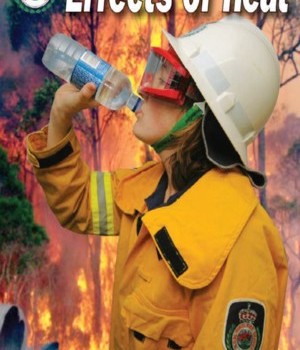In the last decade there have been a number of developments which are pulling Australian bushfire management in opposing directions. These include: publication of several Australian compendia on ecology and management of fires, transfer of large areas of multiple use forests into national parks and the declaration of roadless wilderness areas, listing of frequent fire as a threatening process under environmental legislation, many very large and damaging fires and subsequent government enquiries, a number of international conferences on fire management, establishment of the Bushfire Cooperative Research Centre (CRC), a current trend of global warming, declining rainfall or droughts in parts of Australia, declining forest health in long unburnt areas and the ever-increasing numbers of Australians living at the urban/rural interface. Some of these developments are tempering the counter revolution, but the overall imbalance remains.
Working in the Heat

Fatigue and heat stress are major causes of injury during the summer months. Heat stress or heat illness is a serious condition that can result in organ failure or death if work in hot conditions is not safety managed.
Fatigue and heat stress can reduce a worker’s performance and productivity, plus increase the chance of injury by reducing the ability to concentrate, recognise risks and communicate effectively.
During the hottest months, outdoor workers and those working in hot environments are the most at risk.
This is why everyone should keep an eye out for each other and work together to minimise the effect of heat.
The VFFA welcomes changes to the Emergency Services Levy
The Volunteer Fire Fighters Association (VFFA) congratulates the NSW State Government on the news that an Emergency Services Property Levy will replace the current insurance based model.
This is a much fairer system of collecting funds for firefighting and state emergency services in NSW, it will spread the financial burden of the emergency services levy, and means that the majority of property owners will pay less.
VFFA 2015 Vol 7 No 2 (Summer)
The Summer 2015 edition of the VFFA Magazine is now available for viewing and download.
Your rights under lights and siren – By Michael Eburn
Michael Eburn says that he is asked this question by a NSW volunteer and jumps to a quick conclusion – lights and sirens don’t give you any rights.
The question was: I was told other vehicles must give way to emergency vehicles when under lights and sirens but I’ve also been told that if you’re under lights and sirens it does not give you the right-of-way. Of course you have to take care at all times but I’m interested in know what rights does the driver of an emergency services vehicles under lights and sirens have.
Radio 2WEB gives our shiny new magazine rave reviews
Our Media Officer, Jon Russell spends some time “On Air” with Mel Millgate from Radio 2WEB – www.outbackradio.com.au
Mel asked Jon about the beginnings of the Volunteer Fire Fighters Association. They discussed the selection of magazine content, requests from VFFA members and the fact that many of our readers prefer a printed hard copy magazine.
Bushfire greenhouse gas emissions – from mild to wild
Researchers have conducted the first-ever experiments to prove that fuel reduction burning prior to wildfire decreases both the intensity of wildfire and reduces the amount of carbon and greenhouse gas emitted to the atmosphere. Nerissa Hannink reports.
Wow – Christmas Already
It’s that wonderful time of the year where we generally catch up with family and friends.
It has been a big year for the VFFA with many great projects, campaigns and opportunities for our ever growing membership base.
We would like to take this opportunity to wish all RFS Volunteers (not just VFFA members) a very Merry Christmas and a Happy New Year.
The NSW Rural Fire Service could not exists without it’s volunteer workforce and I’m sure that I can speak for the majority of NSW residents when I say thank you to all fire fighters (volunteers, part time and full time) for their efforts throughout 2015.
